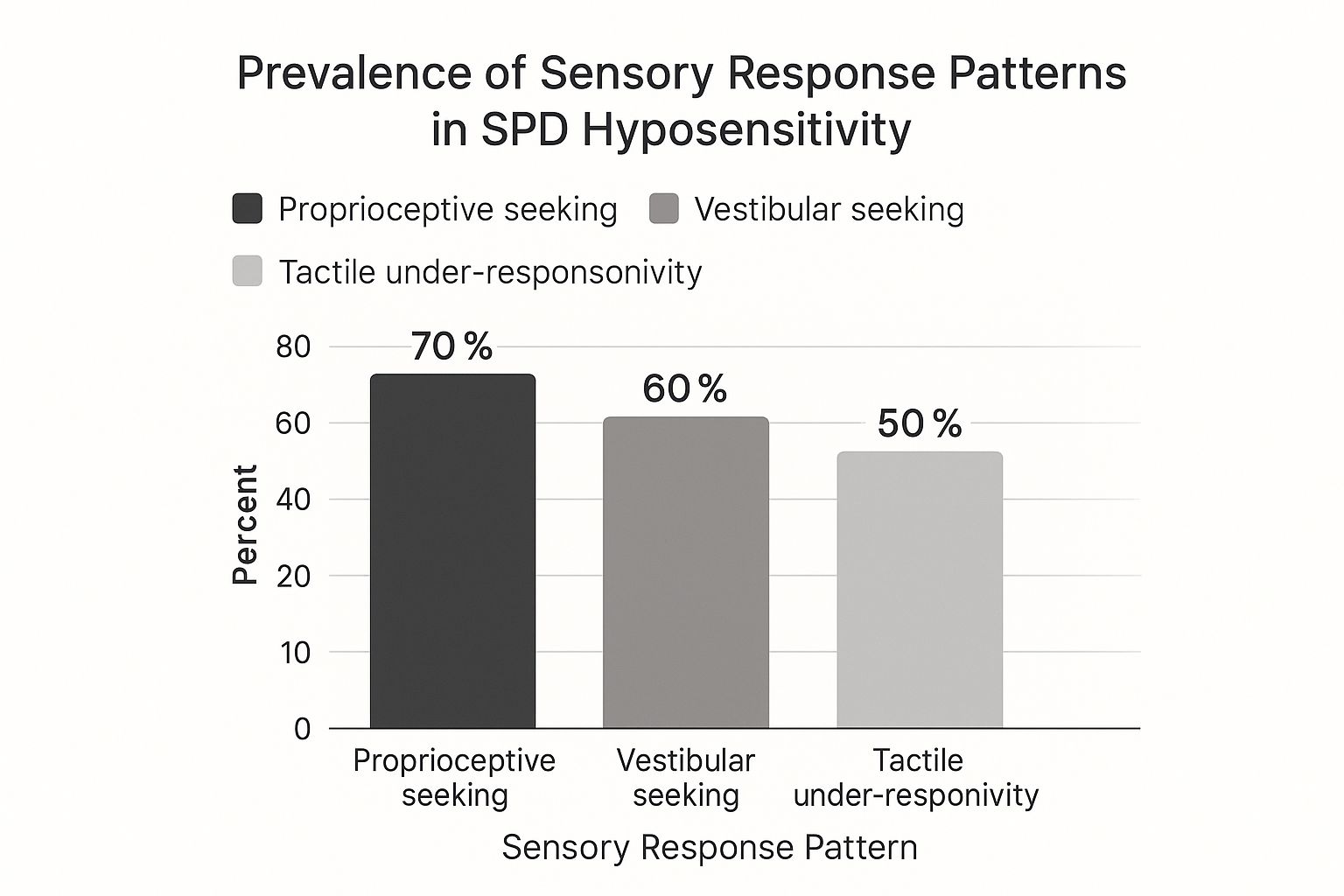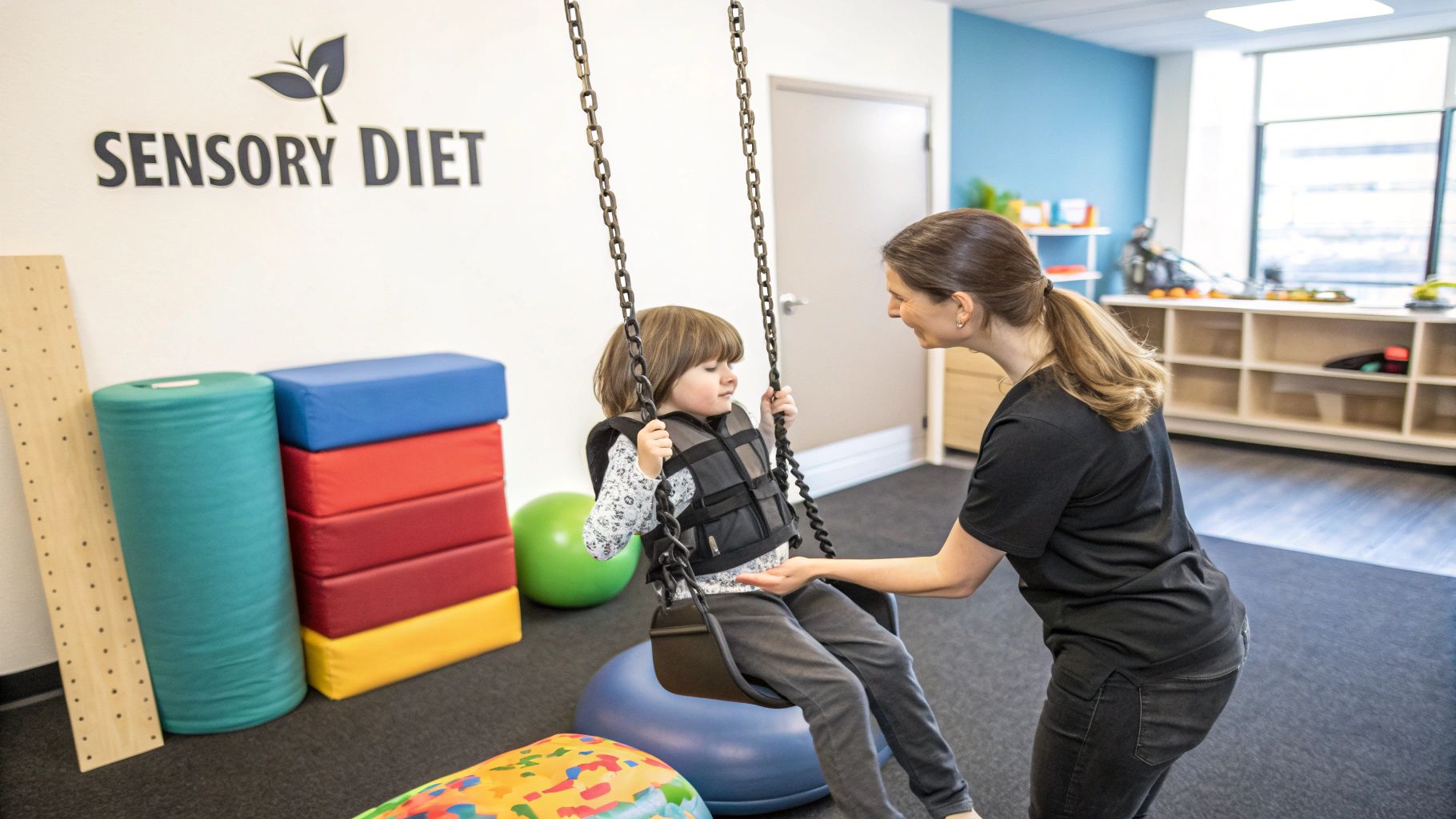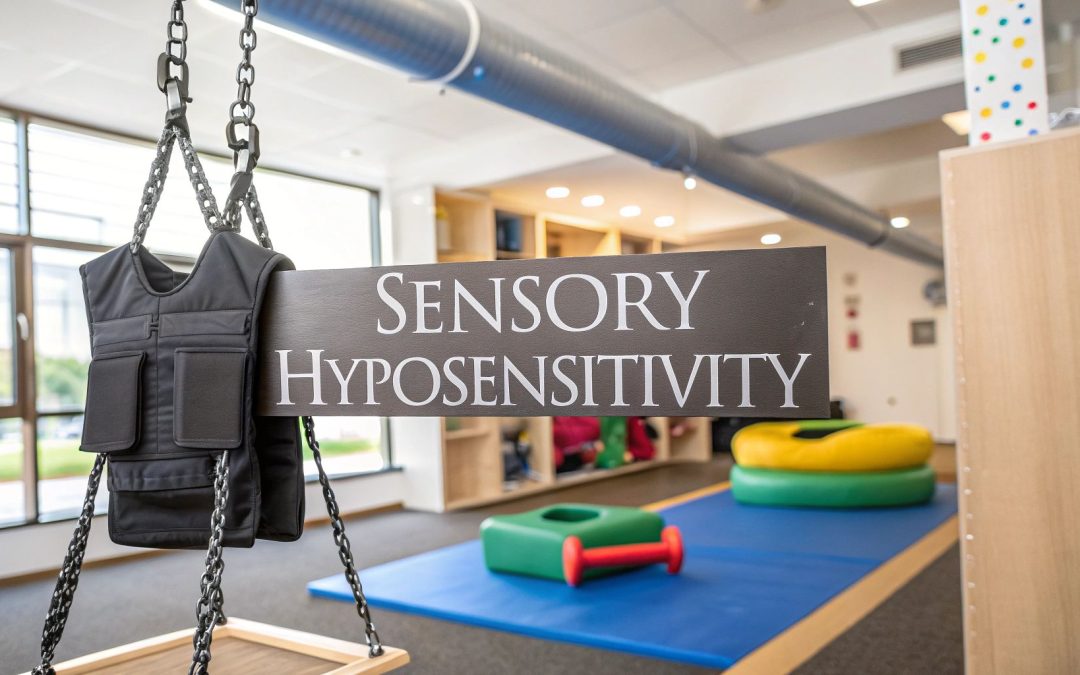Sensory Processing Disorder (SPD) Hyposensitivity, which you might also hear called sensory under-responsivity, is a condition where the brain struggles to register and make sense of incoming sensory information. For a child with hyposensitivity, it means they need a lot more intense sensory input just to understand their own body and the world around them. This is often why you see sensory-seeking behaviors like constant crashing or spinning.
What Is Sensory Processing Disorder Hyposensitivity
Think of your nervous system like a radio receiver. For most of us, the signal comes through loud and clear at a normal volume. But for a child with sensory processing disorder hyposensitivity, it’s as if that volume knob is stuck on low. Their brain needs the sensory "signal" turned way, way up just to even notice it’s there.
This isn't a behavioral choice—it's a neurological reality. The brain's threshold for detecting sensory input is just set unusually high. It takes a huge amount of stimulation for a sensation to finally get registered and processed correctly. This can show up in any of the eight senses, from touch and sound to balance (vestibular) and body awareness (proprioception).
In essence, a person with hyposensitivity is almost "sensory-numb" to certain inputs. Their constant motion, loud noises, and desire for intense physical contact are really just attempts to generate enough sensory feedback for their brain to feel organized, aware, and regulated.
Understanding the Sensory Drive
Because their internal sensory world feels so quiet and muted, kids with hyposensitivity often become active "sensory seekers." They are constantly, and unconsciously, driven to find ways to crank up the volume on their daily experiences. This powerful drive shows up in all sorts of behaviors that can easily be misunderstood as just hyperactivity or defiance.
You might notice common sensory-seeking behaviors like:
- Constant Movement: Fidgeting, rocking back and forth, spinning in circles, or just being completely unable to sit still.
- Intense Physical Contact: Giving hugs that are a little too forceful, crashing into furniture on purpose, or absolutely loving rough-and-tumble play.
- Oral Fixation: Chewing on things that aren't food, like shirt collars, pencils, or fingernails.
- High Pain Tolerance: Seeming not to notice cuts, scrapes, or bruises, or being totally unfazed by falls that would have other kids in tears.
These actions are the nervous system’s way of shouting for the feedback it desperately needs to function. Seeing the behavior for what it is—a neurological need—is the first real step toward providing helpful support instead of just trying to make it stop.
How Common Is Hyposensitivity
Sensory processing challenges are far more widespread than most people think. While every child's experience is unique, the numbers are significant. Studies suggest that as many as 16% of children in the general population deal with some form of sensory processing difficulty, which includes both over- and under-responsivity. Hyposensitivity involves a dampened response to sensory signals, which can often be mistaken for misbehavior instead of a condition that needs compassionate support. To dig a little deeper, you can explore more about how hyposensitivity is defined on pxdocs.com.
The chart below shows some of the most common sensory-seeking patterns we see in individuals with SPD hyposensitivity.

As the data shows, proprioceptive seeking—which is getting input to the muscles and joints—is the most common pattern. This really drives home why behaviors like crashing, jumping, and wanting deep pressure are so incredibly prevalent for these kids.
How to Recognize the Signs of Hyposensitivity

Learning to recognize the signs of sensory processing disorder hyposensitivity is a bit like learning a new language—the unique language of your child's behavior. Instead of just seeing a child who seems "disruptive" or "clumsy," you start to see a kid whose nervous system is desperately trying to get the information it needs to feel organized and understand the world.
These behaviors aren't on purpose; they are the body’s very real, very natural response to an under-responsive sensory system. Think of it like a radio with the volume turned way down—the child has to keep turning the dial way up to hear the music.
The real key is spotting patterns. We're looking for intense, frequent, and often prolonged sensory-seeking actions that get in the way of everyday life. For example, most kids enjoy a bit of roughhousing. But a child with proprioceptive hyposensitivity might need it constantly, unable to settle down without that powerful, deep-pressure input.
Proprioceptive and Vestibular Seeking Behaviors
The proprioceptive system (our sense of body awareness) and the vestibular system (our sense of balance and movement) are often where the most obvious signs of hyposensitivity show up. When a child's system is under-responsive in these areas, they're on a constant quest for information about where their body is and how it’s moving.
This often looks like a child who is in perpetual motion. They are the kids who give bone-crushing hugs, not because they’re trying to be rough, but because they genuinely need to feel that intense joint compression to even register the sensation of a hug.
You might notice signs like:
- Crashing and Bumping: Purposefully running into furniture, walls, or even people.
- Constant Jumping: Bouncing on the sofa, beds, trampolines, or just jumping on the spot.
- Spinning and Swinging: An almost endless desire to spin in circles or swing super high, often without ever seeming to get dizzy.
- Heavy Lifting and Pushing: Enjoying tasks that involve pushing heavy things, like a laundry basket filled with books or moving furniture.
This constant drive for movement isn't just about a kid having "too much energy." It’s a fundamental attempt to give the brain the strong, clear signals it needs to feel grounded and organized. Without this input, a child can feel disconnected from their own body.
Tactile, Oral, and Olfactory Signs
Hyposensitivity can also pop up in the senses related to touch, taste, and smell. For the tactile system, an under-responsive child might have an unusually high pain tolerance. They might not even notice a scrape, a bruise, or extreme temperatures until someone else points it out.
They might also be oblivious to their face being messy after a meal or their clothes being twisted and uncomfortable. This isn't carelessness; their brain simply isn't picking up on the tactile signals that would prompt most of us to wipe our face or fix our shirt.
A Closer Look at Sensory Seeking Behaviors
To help you connect these behaviors to their underlying sensory needs, here’s a quick breakdown of common signs you might see across the different systems.
| Sensory System | Common Observable Behaviors and Signs |
|---|---|
| Vestibular (Movement) | Loves to spin, swing, and hang upside down without getting dizzy; always in motion. |
| Proprioceptive (Body Awareness) | Gives tight hugs, crashes into things, loves jumping, enjoys heavy lifting or pushing. |
| Tactile (Touch) | Has a high pain tolerance; may not notice messy hands/face or uncomfortable clothing. |
| Oral (Mouth) | Chews on non-food items (shirt collars, pencils); prefers intensely flavored or crunchy foods. |
| Auditory (Hearing) | Seems to ignore loud noises; enjoys loud music or TV; makes loud sounds. |
| Visual (Sight) | Fascinated by bright, flashing lights or spinning objects; loves vibrant colors. |
| Olfactory (Smell) | Seeks out strong smells; may smell objects, food, or even people frequently. |
Recognizing these patterns helps shift our perspective from trying to "correct" a behavior to understanding and meeting a fundamental need.
Oral Sensory Seeking
One of the most common signs we see is a constant need for oral input. This happens because the mouth is packed with sensory receptors, making it a super-effective way for a child to get intense sensory feedback. You might observe:
- Chewing on things that aren't food, like shirt collars, pencils, or toys.
- A strong preference for foods with big flavors—think spicy, sour, or extra crunchy.
- Frequently making noises with their mouth, like clicking, humming, or buzzing.
These behaviors are so much more than just "bad habits." Understanding what's driving them is the first step toward real support. You can learn more about the complexities of sensory seeking behaviour in our detailed article on the topic.
When you recognize these actions as a form of self-regulation, you can provide the right support, like offering safe chewelry or crunchy snacks. This allows you to meet the need instead of just trying to stop the behavior—a shift that can make a world of difference for a child's focus and emotional balance.
Hyposensitivity and Its Link to Neurodevelopmental Conditions
When we see those intense, sensory-seeking behaviors that come with sensory processing disorder hyposensitivity, it's hard to miss how often they show up alongside neurodevelopmental conditions like Autism Spectrum Disorder (ASD) and Attention-Deficit/Hyperactivity Disorder (ADHD). This isn't just a coincidence—these sensory challenges are deeply woven into the very fabric of how these kids experience the world.
For a long time, these behaviors were treated as totally separate issues. Thankfully, we now understand that for many children, they are fundamental parts of the same picture. This shift in thinking is so important because it allows us to support the whole child, not just manage a list of isolated symptoms.
The Connection Between Autism and Hyposensitivity
The link between sensory processing difficulties and autism is incredibly strong. In fact, sensory-related symptoms are now officially part of the core diagnostic criteria for ASD, because the vast majority of autistic individuals simply process sensory information differently than their neurotypical peers.
Sensory challenges, including hyposensitivity, are especially common. Some research suggests that around 90% of individuals with ASD have significant sensory processing difficulties, with a large number of them having an under-responsive system. This recognition has completely reshaped how we see autism, highlighting that these sensory differences are a central part of the autistic experience. You can learn more about the relationship between autism and sensory processing on ambitionsaba.com.
For an autistic child with hyposensitivity, the constant search for input isn't a distraction from their world—it is how they connect with their world. The need for deep pressure, intense movement, or loud sounds helps them feel present and organized in their own bodies.
This under-responsivity can spill over into other areas, too:
- Social Cues: A child might miss subtle changes in someone's tone of voice or body language because the sensory input is just too faint for their brain to register and process effectively.
- Repetitive Behaviors (Stimming): Actions like rocking, flapping hands, or humming are often powerful ways to generate predictable, self-regulating sensory input that their nervous system desperately craves.
Understanding Hyposensitivity in ADHD
While sensory issues are a diagnostic hallmark of autism, they are also extremely common in kids with ADHD. Think about it: the constant motion, fidgeting, and impulsivity that we associate with hyperactivity often have a sensory root. That non-stop need to move and seek stimulation is often the ADHD brain’s way of trying to "wake itself up" and stay focused.
For a child with both ADHD and hyposensitivity, their sensory-seeking behaviors can look almost identical to hyperactivity.
- Fidgeting and Restlessness: That kid who is always tapping their feet, clicking a pen, or squirming in their seat? They may be instinctively trying to get the sensory input their body needs to stay alert and engaged in the lesson.
- Impulsivity: Running, jumping, or climbing without seeming to think about the risks can be driven by a powerful need for intense vestibular and proprioceptive feedback.
- Difficulty with Quiet Tasks: Sitting still for long periods offers very little sensory input, making it incredibly difficult for a hyposensitive system to stay regulated and pay attention.
Recognizing this overlap is the key. These actions are not about intentional defiance or a lack of discipline. They are a neurobiological drive to get the nervous system back into a state of balance. When we understand that a child's behavior is often their way of communicating a sensory need, we can finally move from correction to connection. We can start giving them the support their nervous system truly requires to thrive.
Finding What Works: Effective Strategies for Hyposensitivity

Once you understand the "why" behind your child's constant need for more sensory input, the next step is finding practical ways to meet that need. With sensory processing disorder hyposensitivity, the goal isn't to shut down their sensory-seeking behaviors. It’s about channeling that drive into safer, more organized, and truly effective activities that give their nervous system the powerful feedback it craves.
This is a proactive approach. Instead of just managing challenging behaviors as they pop up, we're building a foundation of neurological regulation. When a child's nervous system finally gets the intense input it's been looking for, they are so much more available to focus, engage with others, and participate in daily life. Occupational Therapy (OT) is a cornerstone of this work, providing structured, evidence-based strategies to help.
The Power of a "Sensory Diet"
An occupational therapist will often put together what’s called a “sensory diet.” And no, it has nothing to do with food! It’s a carefully personalized schedule of sensory activities designed to feed the nervous system the specific input it needs to stay balanced and organized all day long.
Think of it just like a nutritional diet. Your body needs a steady intake of healthy food to function at its best. In the same way, a hyposensitive nervous system needs a regular diet of intense sensory input to stay regulated. A sensory diet delivers this through planned activities, helping to prevent the system from getting “hungry” and resorting to crashing, bumping, or other less-than-ideal behaviors.
A typical sensory diet might include things like:
- Morning Wake-Up: Starting the day with big movements like jumping on a mini-trampoline or doing animal walks (think crab walks or bear crawls) to wake up the muscles and joints.
- School Support: Using a wobble cushion on their chair to allow for small movements, or taking scheduled "heavy work" breaks, like carrying a stack of books to the library.
- After-School Reset: Spending time on a swing, crashing into a pile of soft pillows, or having a safe, supervised wrestling match with a sibling.
- Bedtime Wind-Down: Using a weighted blanket or getting deep-pressure massages to help the nervous system finally calm down and prepare for sleep.
Consistency is everything. By weaving these activities into the daily routine, we can help keep the nervous system regulated and reduce that constant, almost desperate search for stimulation.
Sensory Integration Activities That Really Work
Sensory integration therapy, usually guided by an OT, uses fun and engaging activities to help the brain learn how to process sensory information more effectively. For kids with sensory processing disorder hyposensitivity, the therapy is laser-focused on providing powerful proprioceptive (body awareness) and vestibular (movement) input.
The idea here is to deliver concentrated doses of the exact sensory information the brain has been missing. This helps build stronger neural pathways, allowing the brain to get better at registering and responding to sensations over time.
Heavy Work Activities
“Heavy work” is any activity that involves pushing, pulling, or carrying things. It provides a ton of feedback to the muscles and joints (proprioception), which is incredibly calming and organizing for an under-responsive nervous system.
You can easily build this into your day:
- Pushing a laundry basket full of toys or books across the room.
- Helping bring in groceries, especially heavier bags of apples or potatoes.
- Playing a good old-fashioned game of tug-of-war.
- Shoveling snow in the winter or raking leaves in the fall.
These aren't just chores; for a sensory seeker, they are deeply therapeutic tasks that satisfy a real neurological need.
Vestibular Input
Activities that get the vestibular system firing help the brain understand where it is in space, how it’s moving, and how to balance.
Some great examples are:
- Swinging, either on a playground or a specialized therapy swing.
- Spinning in an office chair (with supervision, of course!).
- Hanging upside down from the monkey bars.
- Rolling down a big grassy hill.
Setting Up the Environment for Success
Sometimes, simple changes to a child's environment can make all the difference. You don't always need a formal activity.
- Create a Crash Pad Corner: Designate a safe spot in the house with pillows, beanbags, and cushions where your child is allowed to crash and jump.
- Provide "Chewelry": If your child is constantly chewing on their shirt collar or pencils, offer safe chewable necklaces or pencil toppers to meet that oral sensory need.
- Use Weighted Tools: A weighted lap pad during story time or a weighted vest during seated activities can provide that calming deep pressure input without any effort.
By combining these strategies, you can create a supportive world that meets your child's sensory needs proactively. It’s also important to explore different therapeutic avenues to find what works for your family. For those interested in a holistic path, learning more about different types of sensory processing disorder therapy can offer valuable insight into building a truly well-rounded support system.
Exploring the Science of Sensory Processing
To really get what’s happening with sensory processing disorder hyposensitivity, we need to peek inside the brain and nervous system. Think of it as a constant, two-way conversation between your body and your brain, with sensory information zipping along communication lines called neural pathways.
Here’s how it’s supposed to work: you touch a cool glass of water. Instantly, receptors in your skin fire off an electrical signal. That signal travels up your nerves, through the spinal cord, and lands in specific processing centers in the brain. The brain gets the message, identifies it as "cool," decides if it’s a big deal, and tells your body how to react—or not to react at all.
But for a hyposensitive nervous system, that communication chain is fuzzy. The signal might be too weak to register, or the brain’s “reception desk” is so busy it requires a much louder, more intense message before it even looks up. The result? The brain stays largely in the dark about what the body is actually experiencing.
The Brain's Volume Control
At the core of all this is a concept called sensory modulation. The easiest way to picture it is as the brain’s master volume control for every sight, sound, and touch coming in. A well-regulated nervous system knows just what to do—it can turn the volume up to focus on a teacher's voice and turn it way down to ignore the humming of the classroom lights.
In hyposensitivity, that volume knob is stuck on low. The brain is constantly under-registering sensory input, which can leave a person feeling disconnected or in a state of sensory fog. This is exactly why a child might spin in circles endlessly and never get dizzy; their brain is desperately craving that intense vestibular input just to get a clear signal that their body is moving.
We now know these are real, measurable differences in brain structure and function. Research has increasingly confirmed a biological basis for these sensory challenges, which helps us move the conversation away from outdated and unhelpful labels like "bad behavior."
This shift in understanding is huge. It validates what individuals with hyposensitivity and their families have known all along and points us toward therapies designed to help the brain process information more effectively. For instance, a major 2013 study gave us critical insights into how sensory processing disorders affect brain connectivity, cementing the reality that these conditions have a clear neurological foundation. This kind of research is what shapes better, more effective support for those living with sensory challenges.
You can learn more about these important findings on the biological basis of sensory processing disorders.
Getting a handle on the science shows us that sensory-seeking behaviors aren't a choice or a discipline issue. They're a smart, instinctual drive to give the brain the information it needs to feel present, organized, and ready to engage with the world.
The Role of Chiropractic Care in Nervous System Health

While Occupational Therapy is a cornerstone for managing sensory processing disorder hyposensitivity, many families also explore complementary approaches that get to the root of the issue—the nervous system. This is where pediatric chiropractic care comes in, offering a unique focus on the profound link between spinal health and neurological function.
Think of your child’s nervous system as the body’s communication superhighway. The brain is the control tower, and the spinal cord is the main freeway connecting it to every part of the body. Every bit of sensory information, from the warmth of a hug to the feeling of their feet on the grass, has to travel this highway to be understood.
Chiropractic care works on a simple but powerful principle: misalignments in the spine, which we call subluxations, can create "traffic jams" on this superhighway. This static or interference can disrupt the vital flow of information between the brain and body, potentially muddying how sensory signals are perceived.
Enhancing Brain-Body Communication
For a child with hyposensitivity, their brain is already struggling to register sensory signals. It's like trying to listen to a radio station with a weak signal. That’s why it's so important to make sure the communication lines are as clear as they can possibly be.
The goal of gentle, specific pediatric chiropractic adjustments is to reduce these "traffic jams" and clear the static in the nervous system.
By carefully restoring proper alignment and motion in the spine, chiropractic care aims to improve the quality and clarity of the signals traveling to and from the brain. It's not about "curing" the sensory condition itself. Instead, the focus is on optimizing the underlying neurological framework that supports all sensory processing. When the brain receives a clearer picture from the body's sensors, its ability to make sense of the world is naturally supported.
A well-functioning nervous system is the foundation of sensory health. By clearing interference, chiropractic care helps ensure the brain receives the most accurate sensory picture possible, which is essential for proper development and regulation.
A Supportive, Integrated Approach
It’s important to see chiropractic care not as a standalone cure, but as a key piece of the puzzle that works hand-in-hand with therapies like OT. Many parents tell us that adding chiropractic care to their child's routine provides another crucial layer of support for their overall development and well-being.
This approach helps create an internal environment where the nervous system can do its job with greater ease. If you want to dive deeper into this, our guide on chiropractic and the nervous system breaks down the connection in more detail.
Ultimately, by addressing the foundational health of the nervous system, chiropractic care can help a child's body better adapt to sensory inputs and get more out of their other therapies. It’s all about creating a well-rounded path to helping your child thrive.
Common Questions About Sensory Hyposensitivity
As you dive deeper into the world of sensory processing disorder hyposensitivity, it’s completely normal for questions to pop up. For parents, teachers, and caregivers, getting a handle on the nuances of this condition is the first step toward providing real support. Let's walk through some of the most common questions we hear.
Is Sensory Hyposensitivity Just a High Pain Tolerance?
That’s a great question, and it’s one we get all the time. While a high tolerance for pain is definitely a common sign of tactile hyposensitivity, the two aren't the same.
Hyposensitivity is a much broader neurological condition where the brain simply doesn't register the full intensity of all kinds of sensory input, not just pain. A child might not notice their hands are covered in paint, that their shirt is on backward, or that the room is getting chilly. It's a diminished response across the board, making it a comprehensive processing difference, not just an isolated tolerance to pain.
Can a Child Outgrow Sensory Hyposensitivity?
Sensory processing differences are generally seen as a lifelong part of a person's unique wiring. But that absolutely does not mean challenges can't be overcome or that a person can't learn to thrive.
Through things like Occupational Therapy and a consistent sensory diet, kids and adults learn incredible self-regulation strategies. They figure out how to get the intense sensory input their bodies crave in safe and appropriate ways. This empowers them to navigate any environment with confidence, turning what was once a daily struggle into a manageable part of who they are.
How Is Hyposensitivity Different From Hypersensitivity?
Think of them as two sides of the same coin—they are opposite reactions within the nervous system. Getting this distinction right is key to providing the right kind of support.
- Hyposensitivity (Under-Responsive): This is an under-reaction to the world. The nervous system's "volume dial" is turned way down, so a person has to seek out more intense stimulation—like loud noises, constant spinning, or deep pressure—just to feel registered and regulated.
- Hypersensitivity (Over-Responsive): This is an over-reaction. Here, the volume dial is cranked way up. Everyday sensations that most people barely notice, like the tag on a shirt, bright fluorescent lights, or a dog barking down the street, can feel completely overwhelming.
It's also very common for someone to have a mixed sensory profile. They might be hyposensitive in one area (like needing to crash and jump all day) while being hypersensitive in another (like finding certain food textures unbearable).
Is Sensory Seeking Always a Sign of Hyposensitivity?
Not always, but there is an extremely strong link between the two. The truth is, we all engage in some sensory-seeking behaviors to keep ourselves regulated. Ever tap your foot when you're bored or stretch your arms out wide after sitting for a while? That’s sensory seeking in action.
The difference is a matter of degree. When these behaviors become so intense and persistent that they start to interfere with daily life—learning, playing, or socializing—they often point directly to an under-responsive nervous system. It's the body's natural, intuitive way of trying to generate enough input to feel present, organized, and in control. An occupational therapist is the best professional to help figure out the root cause and build a supportive plan.
At First Steps Chiropractic, we focus on helping the nervous system function optimally so your child can better process and adapt to their world. If you're looking for a supportive approach to complement your child's sensory therapies, we invite you to learn more about our neurologically-focused care.

